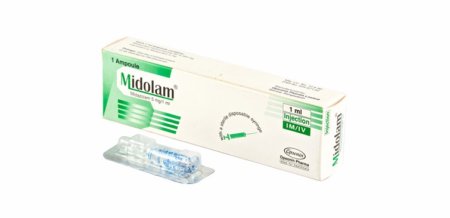
Type:Injection
Generic Name:Midazolam
Manufacturer:Opsonin Pharma Limited
Price:৳50.35
Short-term treatment of insomnia. Sedation in premedication before surgical or diagnostic procedures.
May be taken with or without food. Midazolam IV should be administered very slowly.
Adult Oral Short-term management of insomnia Adult: 7.5-15 mg at bedtime. Elderly: 7.5 mg at bedtime. Hepatic impairment: Mild to moderate: Dosage reduction needed. Severe: Contraindicated. Parenteral Preoperative Sedation IM Adult: 0.07-0.1 mg/kg bodyweight i. m. Usual dose is about 5 mg. Elderly and debilitated patients: 0.025-0.05 mg/kg IV Endoscopic or Cardiovascular Procedures In healthy adults the initial dose is approximately 2.5 mg. In cases of severe illness and in elderly patients, the initial dose must be reduced to 1 to 1.5 mg. Induction of Anesthesia The dose is 10-15 mg I. V.
Oral Seizures Child: 3-6 mth Hospital setting: 2.5 mg; >6 mth to <1 yr 2.5 mg; 1-<5 yr 5 mg; 5-<10 yr 7.5 mg; 10-<18 yr 10 mg. Doses are given as single dose. Sedation 500-750 mcg/kg PO once diluted by juice 20-30 minutes prior to procedure; not to exceed 20 mg Rectal administration in children: For preoperative sedation, rectal administration of the ampoule solution (0.35-0.45 mg/kg) 20-30 min before induction of general anesthesia. Parenteral Sedation IM 100-150 mcg/kg IM; up to 500 mcg/kg used; not to exceed 10 mg IV <6 months: Initial, 50 mcg/kg IV over 2-3 minutes; titrate with small increments to clinical effect; monitor closely 6 months-6 years: Initial, 50-100 mcg/kg IV over 2-3 minutes; repeat q2-3min PRN; may require up to 600 mcg/kg total dose; not to exceed 6 mg total dose 6-12 years: Initial, 25-50 mcg/kg IV over 2-3 minutes; repeat q2-3min PRN; may require up to 400 mcg/kg; not to exceed 10 mg total dose Anesthesia (Non-neonatal) Loading dose: 50-150 mcg/kg IV over 2-3 minutes PRN to achieve desired effect Continuous infusion: 1-2 mcg/kg/min IV infusion Anesthesia (Neonatal) IV loading dose should not be used in neonates Continuous infusion: 0.5 mcg/kg/min IV infusion
Severe resp failure or acute resp depression, acute narrow-angle glaucoma, myasthenia gravis, sleep apnoea syndrome; severe hepatic impairment (oral). Concomitant use w/ potent CYP3A4 inhibitors.
Midazolam is a short-acting benzodiazepine. It exerts sedative and hypnotic, muscle relaxant, anxiolytic and anticonvulsant actions. While the probable anxiolytic action might be as a result of the drug's ability to increase glycine inhibitory neurotransmitter level, the hypnotic/anaesthetic action may be due to the occupation of the benzodiazepine and GABA receptors leading to membrane hyperpolarisation and neuronal inhibition, and further interfering with the re-uptake of GABA at the synapses.
Patients w/ heart failure, impaired gag reflex, resp disease, history of alcohol or drug abuse. Patient at risk of falls. Hepatic and renal impairment. Childn, elderly and debilitated patient. Pregnancy and lactation. Avoid abrupt withdrawal after prolonged use. Avoid rapid inj in neonates. Patient Counselling May impair ability to drive or operate machinery. Monitoring Parameters Monitor resp and CV status, BP. Lactation: Distributed in breast milk, use caution
>10% Decreased respiratory rate (23%),Apnea (15%) 1-10% Drowsiness (1-5%),Seizure-like activity (1%),Nausea/vomiting (3%),Cough (1%),Pain at injection site (4-5%) Frequency Not Defined Headache,Sedation,Hiccoughs,Delirium,Euphoria Pediatric Desaturation,Hypotension,Seizurelike activity,Nystagmus,Paradoxical reactions,Hiccoughs,Apnea
Midazolam should be avoided during pregnancy unless there is no safer alternative. Since Midazolam passes into breast milk, it should not be administered to breast-feeding mothers.
Increased CNS depression with alcohol, opioids, barbiturates, other sedatives and anaesthetics. Increased respiratory depression with opiates, phenobarbital, other benzodiazepines. Plasma concentrations increased by CYP3A4 inhibitors such as cimetidine, erythromycin, clarithromycin, diltiazem, verapamil, ketoconazole and itraconazole, antiretroviral agents, quinupristin with dalfopristin. Midazolam concentration decreased by phenytoin, carbamazepine, phenobarbital, rifampicin. Halothane, thiopental requirements may be reduced during concurrent use.